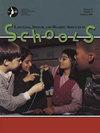The Effect of Sampling Context on Preschoolers' Finite Verb Morphology Composite Scores.
IF 2.9
3区 医学
Q1 AUDIOLOGY & SPEECH-LANGUAGE PATHOLOGY
Language Speech and Hearing Services in Schools
Pub Date : 2024-07-30
DOI:10.1044/2024_lshss-23-00194
引用次数: 0
Abstract
PURPOSE The finite verb morphology composite (FVMC) is a valid measure for charting children's tense development and for differentiating children with and without language impairment during preschool and early elementary years. However, it is unclear whether FVMC scores vary as a function of language sample elicitation contexts. The current study evaluated the performance on FVMC in preschool-aged children across different language sampling contexts. METHOD Participants were 38 English-speaking children who were between the ages of 3 and 4 years and below the mastery level of tense usage in three language sampling contexts, including conversation (free-play), picture description, and narratives (story retell). FVMC from each sampling context was computed by calculating the overall accuracy of copula be, auxiliary be, third-person singular present -s, and past tense -ed combined. A linear mixed-effects model comparison was carried out to determine the effect of sampling context on FVMC scores. RESULTS After controlling for child age, mean length of utterance, and the number of obligatory contexts for FVMC scoring, FVMC scores were significantly higher in conversation than in picture description and narratives. In addition, FVMC scores across the three sampling contexts were significantly correlated (rs ≥ .62, p < .001). CONCLUSIONS Although children's performance on FVMC relative to each other was quite stable across sampling contexts, FVMC scores may vary with sampling contexts. As compared to picture description and narratives, conversation may not adequately capture the limitation in preschoolers' tense development that is important for therapeutic planning.抽样情境对学龄前儿童有限动词词形综合得分的影响
目的有限动词词形综合(FVMC)是一种有效的测量方法,可用于绘制儿童的时态发展图,以及区分学龄前和小学低年级有语言障碍和无语言障碍的儿童。然而,目前尚不清楚 FVMC 分数是否会随着语言样本激发语境的变化而变化。本研究评估了学龄前儿童在不同语言抽样情境中的 FVMC 表现。方法:本研究的参与者是 38 名 3-4 岁的英语儿童,他们在三种语言抽样情境中的时态用法低于掌握水平,包括对话(自由游戏)、图片描述和叙述(故事复述)。每个抽样情境中的 FVMC 是通过计算共轭词 be、助词 be、第三人称单数现在时 -s 和过去时 -ed 的综合准确率来计算的。结果在控制了儿童年龄、平均语篇长度和 FVMC 评分所需的语境数量后,对话中的 FVMC 评分明显高于图片描述和叙述中的 FVMC 评分。此外,三种取样情境中的 FVMC 分数有明显的相关性(rs ≥ 0.62,p < 0.001)。结论虽然儿童在不同取样情境中的 FVMC 表现相对稳定,但 FVMC 分数可能会随取样情境的不同而变化。与图片描述和叙述相比,谈话可能无法充分捕捉到学龄前儿童时态发展的局限性,而这对于制定治疗计划非常重要。
本文章由计算机程序翻译,如有差异,请以英文原文为准。
求助全文
约1分钟内获得全文
求助全文
来源期刊

Language Speech and Hearing Services in Schools
Social Sciences-Linguistics and Language
CiteScore
4.40
自引率
12.50%
发文量
165
期刊介绍:
Mission: LSHSS publishes peer-reviewed research and other scholarly articles pertaining to the practice of audiology and speech-language pathology in the schools, focusing on children and adolescents. The journal is an international outlet for clinical research and is designed to promote development and analysis of approaches concerning the delivery of services to the school-aged population. LSHSS seeks to advance evidence-based practice by disseminating the results of new studies as well as providing a forum for critical reviews and meta-analyses of previously published work.
Scope: The broad field of audiology and speech-language pathology as practiced in schools, including aural rehabilitation; augmentative and alternative communication; childhood apraxia of speech; classroom acoustics; cognitive impairment; craniofacial disorders; fluency disorders; hearing-assistive technology; language disorders; literacy disorders including reading, writing, and spelling; motor speech disorders; speech sound disorders; swallowing, dysphagia, and feeding disorders; voice disorders.
 求助内容:
求助内容: 应助结果提醒方式:
应助结果提醒方式:


